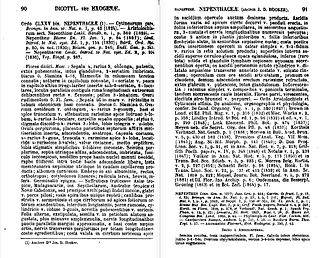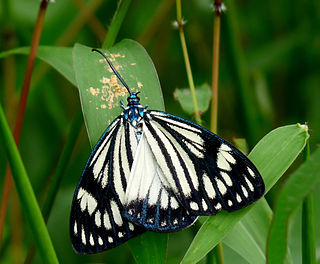
Nepenthes khasiana is an endangered tropical pitcher plant of the genus Nepenthes. It is the only Nepenthes species native to India. It is thought to attract prey by means of blue fluorescence.
Ilex khasiana is a species of plant in the Aquifoliaceae family. It is endemic to India. Four very rare specimens grow on Shillong Peak, 10 km west of Shillong, Meghalaya, northeast India.
Ixonanthes khasiana is a species of plant in the Ixonanthaceae family. It is endemic to northeast India. It is threatened by habitat loss.
Sterculia khasiana was a species of plant in the family Malvaceae. It was an endemic tree of the Khasi Hills in Meghalaya in India. It became extinct due to habitat loss.
Phacusa was a city in the late Roman province of Augustamnica Prima. It served as a bishopric that was a suffragan of Pelusium, the metropolitan see of that province.

"Nepenthaceae" is a monograph by Joseph Dalton Hooker on the tropical pitcher plants of the genus Nepenthes. It was published in 1873 in the seventeenth and final volume of Augustin Pyramus de Candolle's Prodromus Systematis Naturalis Regni Vegetabilis, which was edited by Augustin's son, Alphonse. The monograph focused primarily on new discoveries from northern Borneo. Unlike most major works on Nepenthes, it included no illustrations.

Ampelophaga khasiana, the scarce vine hawkmoth, is a moth of the family Sphingidae. It was described by Walter Rothschild in 1895. It is found from Nepal, Sikkim in north-eastern India and to central China.
Eilema khasiana is a moth of the subfamily Arctiinae. It is found in India (Khasis).
Phacusa chalcobasis is a moth of the family Zygaenidae. It was described by George Hampson in 1919. It is found on Sumatra in Indonesia.
Phacusa manilensis is a moth of the family Zygaenidae. It was described by George Hampson in 1919. It is found on Luzon in the Philippines.
Phacusa nicobarica is a moth of the family Zygaenidae. It was described by George Hampson in 1919. It is found on the Nicobar Islands in the eastern Indian Ocean.
Phacusa paracybele is a moth of the family Zygaenidae. It was described by Alberti in 1954. It is found in China.
Phacusa tonkinensis is a moth of the family Zygaenidae. It was described by Alberti in 1954. It is found in Vietnam.
Phacusa birmana is a moth of the family Zygaenidae. It was described by Oberthür in 1894. It is found in Myanmar.
Phacusa discoidalis is a moth of the family Zygaenidae. It was described by Swinhoe in 1903. It is found in northern Vietnam.
Phacusa dolosa is a moth of the family Zygaenidae. It was described by Francis Walker in 1856. It is found in India and Myanmar.
Phacusa inermis is a moth of the family Zygaenidae. It was described by Alberti in 1954. It is found in China.
Phacusa properta is a moth of the family Zygaenidae. It was described by Swinhoe in 1890. It is found in Birma, northern India and the Nicobar Islands.
Phacusa subtilis is a moth of the family Zygaenidae. It was described by Hering in 1925. It is found on Java.
Phacusa tenebrosa is a moth of the family Zygaenidae. It was described by Francis Walker in 1854. It is found in northern India.





